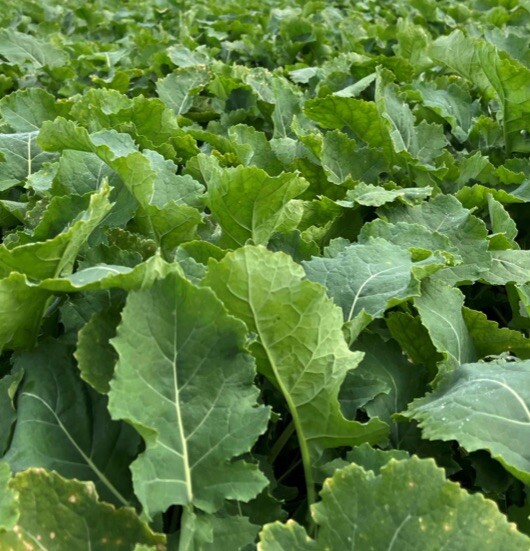Sulphur - how much do you have in the 'bank'?
Sulphur is important for crop growth, especially in canola, but how much is left in our soils given the high rainfall and high yields of the past few seasons?

Key messages:
- Canola crops are especially vulnerable to sulphur deficiency
- Leaching and high rates of plant removal over the past few years have likely reduced soil sulphur levels
- Incremented soil testing to a depth of 60-80cm will identify the quantity and location of sulphur in the soil
- Understanding what’s in the ‘bank’ can help farmers make timely and economical fertiliser decisions
Sulphur (S) is an important nutrient for grain crops as it is used in chlorophyll formation and plant development. Canola has a higher requirement than wheat or legume crops for sulfur thanks to its oil and protein production.
Crops get most of their sulphur from soils. However, Australian soils are generally low in sulphur, with organic matter contributing up to 70-90% of soil sulphur. Cropped soils tend to have lower organic matter and therefore lower sulphur.
In the late 1980s, sulphur deficiency was recognised in southern NSW canola crops and this led to a recommendation for the application of 20–30kg S/ha when sowing canola (GRDC Canola guide, 2009).
Given the frequency of the wheat-canola rotation across the Riverine Plains, and our history of regular sulphur applications, how much do farmers really need to apply this year?
The basics
Soil sulphur needs to go through a mineralisation process, similar to nitrogen, in which it is converted to its plant available form, sulphate.
Like nitrate-nitrogen, sulphate-sulphur is soluble and easily moves down the profile. The extremely wet conditions experienced across the Riverine Plains over the past three years has likely resulted in sulphur being lost from soils. In some cases, leaching may have moved sulphur further down the profile, perhaps settling in a layer at depth (stratification), or it may have been leached beyond the root zone entirely.
A combination of leaching and higher-than-average canola yields over the past three seasons may have depleted soil reserves, with crops at risk of deficiency if maintenance programs haven’t kept up with system losses.
What does deficiency look like and how is it fixed?
Sulphur deficiency can show as pale and mottled leaves from early rosette through to stem elongation in canola. In severe cases, leaves may also be cupped with a purple margin. At flowering, flowers may be pale yellow to cream, with poor podset. Sulphur deficiency can result in significant yield loss, even if symptoms aren’t visibly severe.
Sulphur deficiency can sometimes be confused with nitrogen deficiency, however yellowing occurs in younger leaves instead of the older leaves.
The good news is that sulphur deficiency can quickly be corrected in-crop using mineral sulphate fertilisers, such as sulphate of ammonia, which can recover yield and oil potential if applied before stem elongation.
While it’s important not to underestimate crop requirements, there is still conjecture about how much sulphur is removed by canola. In the past, it was generally accepted that canola needs about 10 kg of sulphate-sulphur per tonne of grain produced, but recent research from the GRDC northern zone suggests that the actual figure could be around half this, meaning maintenance levels could be more like 4-5 kg S per tonne of grain removed. The currently accepted critical value for sulfur at 0-60cm is 31 mg/kg (KCl-40 S+ test), with results below this indicating a potential deficiency.
In canola paddocks with a history of sulphur application, even if it hasn’t been applied recently, there may not necessarily be an economic response to sulfur applications due to high levels of residual sulphur in the subsoil.
But the only way to be sure is to soil test.
Soil testing
Sulphate is highly mobile in the soil and for this reason 0-10cm soil tests are not suitable for diagnosing deficiency. Instead, aim to sample to a depth of 60-80cm and segment tests into 0-30cm and 30-60cm increments (at a minimum). This will provide more information about how much sulphur is in the soil and where it is located. Properly interpreted, the soil test results will also identify any deficiency and how quickly, and at what rate, sulphur will need to be applied.
Growers can piggyback sulphur testing onto deep soil nitrogen (DSN) testing programs, while tissue testing is another option.
Nitrogen and sulphur
Variable responses to sulphur have been observed depending on background nutrition levels in canola. In some cases, this is due to the suboptimal supply of nitrogen, which can inhibit the uptake of sulphur by plants.
During 2017-18, Riverine Plains and GRDC investigated nitrogen supply and sulphur uptake through the Optimising crop nutrition in canola project. The project reinforced basic sulphur nutrition to ensure nitrogen supply is not limited and highlighted the importance of using soil tests to inform sulphur application rates, similar to the way that DSN testing informs urea application rates (rather than relying on standard sulphur application rates with every canola crop).
Summary
Now is the time to manage sulphur deficiency in soils.
If symptoms become visible in canola, or if soil tests indicate a potential deficiency, talk to your agronomist for further information on tissue testing and fertiliser application strategies.
Resources & further reading
Author
NEWS
Keep up to date with the latest news from across the Riverine Plains.
-
Livestock
-
People
-
Grains
-
Sustainability

